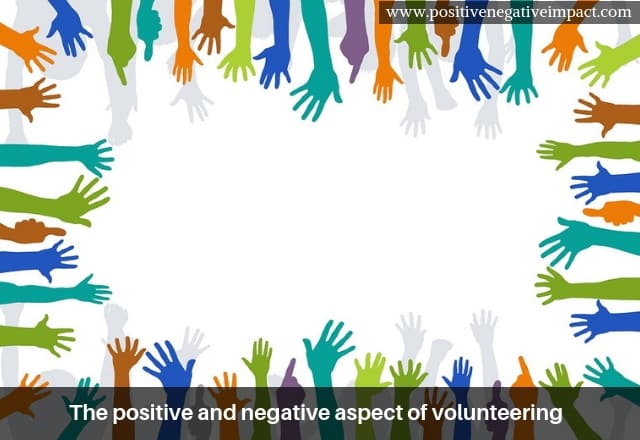Whether you are taking part in volunteerism or into volunteering full time, the fact remains that it enables you to meet people from various walks of life and to help create a positive change for many. The fact remains that nearly half of the world’s population lives on less than 2$ per day and as such, this is the population that’s most at risk from several diseases, natural calamities and disasters. Helping these people out is indeed a worthwhile goal; but more importantly, you need to understand that volunteering comes with its own baggage, both positive and negative. This is why it is important that you take a closer look at some of the positive and negative aspects of volunteering.

Positive Aspects of Volunteering
- Helping those in need: Often, one of the main objectives of any volunteering activity is to help those in need. Taking part in such activities, even though it may put you out of your comfort zone, should nevertheless help you engage meaningfully with people from various walks of life. You should be able to interact with various communities and in a way, form long-term associations and even relationship with some of them. This, in turn, should enable you to understand their circumstances better so that you can provide them with the required assistance.
- Helping vulnerable age groups: One of the aspects of volunteering is to provide a support base for those in need, especially the very young and old and guide them accordingly to ensure that their basic needs are met. Most volunteering activities generally target the adult population with only a few that focuses on vulnerable age groups; the good news is that with an increased focus on the vulnerable age groups, volunteering organizations have started providing specialized services targeting this age group. Some volunteer organizations often provide help in the form of educational assistance as well as ensure that this demographic group has access to basic facilities and are able to get shelters at various homes.
- Helping to build local communities: Often, organizations call for volunteers to either lend manpower or to donate money to help a particular region that has been devastated by a natural event, such as Cyclone. The volunteering activity can include anything from building a school to laying a road; the point being that volunteering activities can differ widely and it depends more on the current needs and what you can do to help those affected with your skills, and talent.
Negative Aspects of Volunteering
- Compensation: Most volunteering activities offer zero compensation and at times, you may be required to shell out for transportation and bear additional expenses on your own. The fact remains that most volunteering organizations are extremely underfunded and as such, are not able to offer their volunteers much by way of compensation. However, some of these organizations have managed to introduce a working model wherein those interested in volunteering can donate to the organization for the privilege of volunteering. This has enabled several volunteer organizations to beef up their activities.
- Health: Some of the volunteering activities can expose you to several pathogens; for example, during the cleanup process post the Asian tsunami, several volunteers reported sick as a result f drinking contaminated water. So if you are planning to volunteer, you need to understand that some of the volunteering activities can expose you to various pathogens and place you at risk of contracting the same. So, you may want to consult your healthcare worker, before volunteering your services and time to help those with need and undertake measures to minimize the risk of any contagion.
- Training: Most volunteering activities require a firm commitment on your part and you are expected to donate your time and services towards the cause, for a certain period. One of the most touted criticisms regarding volunteering is that most volunteers often do not take their commitments seriously and often have little clue about what they are supposed to do. While it would be great if most volunteer organizations had the requisite funds to set up training sessions for fresh volunteers, the fact is that most of these organizations are under-staffed and have limited resources. Given this, it would make more sense for such organizations to develop something in print, which should not cost much but which should help provide all the volunteers with enough information on how to go about providing services to those in need.
These are some of the positive and negative aspects of volunteering; if you are planning to volunteer your services to those in need, it is important that you take some time to understand what may be required of you and how better to utilize your skills for the same.
- Tulip Mania – The Story of One of History’s Worst Financial Bubbles - May 15, 2022
- The True Story of Rapunzel - February 22, 2022
- The Blue Fugates: A Kentucky Family Born with Blue Skin - August 17, 2021
